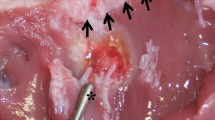Abstract
We investigated the feasibility of using cryogenic technology in an electrode catheter for percutaneous ablation of cardiac tissue. Despite its high success rate, radiofrequency catheter ablation has important limitations especially with regards to the treatment of ventricular arrhythmias associated with a chronic scar. Arrhythmia surgery experience has shown that freezing with a hand held probe can permanently ablate the arrhythmogenic substrate of ventricular tachycardia associated with an old scar. Moreover, cryosurgery also allows for reversible “ice mapping,” in which the area likely responsible for the arrhythmia can be evaluated by suppressing its electrophysiologic properties prior to the creation of an irreversible state. A new steerable cryoablation catheter using Halocarbon 502 as a refrigerant was utilized in six dogs. Serial cryoapplications were performed in the right and left ventricles. In two dogs, we attempted reversible ice mapping of the AV node. Pathological evaluation of the lesions was done acutely in all the animals. Forty-two cryoapplications were delivered at a mean temperature of −45 ± 9.8°C. No lesion was found at pathological evaluation for 16 cryoapplications which did not achieve a temperature of less (colder) than −30°C. The remaining applications resulted in 26 lesions which were hemorrhagic and sharply demarcated from normal myocardium. Histological evaluation revealed contraction band necrosis. Reversible ice mapping of the AV node was successfully achieved in two animals. Cryoablation is feasible using an electrode catheter with multiple electrodes. This technology has the potential to allow for reversible ice mapping to confirm a successful ablation target before definitive ablation.
Similar content being viewed by others
References
Schlüter M, Geiger M, Siebels J, et al. Catheter ablation using radiofrequency current to cure symptomatic patients with tachyarrhythmias related to an accessory atrioventricular pathway. Circulation 1991;84:1644-1661.
Calkins H, Sousa J, El-Atassi R, et al. Diagnosis and cure of the Wolff-Parkinson-White syndrome or paroxysmal supraventricular tachycardias during a single electrophysiologic test. N Engl J Med 1991;324:1612-1618.
Jackman WM, Wang X, Friday KJ, et al. Catheter ablation of accessory atrioventricular pathways (Wolff-Parkinson-White syndrome) by radiofrequency current. N Engl J Med 1991;324:1605-1611.
Klein LS, Miles WM, Hackett FK, et al. Catheter ablation of ventricular tachycardia using radiofrequency techniques in patients without structural heart disease. Herz (Germany) 1992;17:179-189.
Morady F, Harvey M, Kalbfleisch SJ, et al. Radiofrequency catheter ablation of ventricular tachycardia in patients with coronary artery disease. Circulation 1993;87:363-372.
Poty H, Saoudi N, Abdel Aziz A, et al. Radiofrequency catheter ablation of type 1 atrial flutter. Prediction of late success by electrophysiological criteria. Circulation 1995;92: 1389-1392.
Harrison L, Gallagher JJ, Kasell J, et al. Cryosurgical ablation of the A-V node-His bundle. A new method for producing A-V block. Circulation 1977;55:463-470.
Guiraudon GM. Cryoablation, a versatile tool in arrhythmia surgery. Ann Thorac Surg 1987;43 (Editorial): 129-130.
Szabo TS, Jones DL, Guiraudon GM, et al. Cryosurgical modification of the atrioventricular node: A closed heart approach in the dog. J Am Coll Cardiol 1987;10:389-398.
Gillette PC, Swindle MM, Thompson RP, et al. Transvenous cryoablation of the bundle of His. PACE 1991;14:504-510.
Fujino H, Thompson RP, Germroth PG, et al. Histologic study of chronic catheter cryoablation of atrioventricular conduction in swine. Am Heart J 1993;125:1632-1637.
Huang KS, Graham AR, Wharton K. Radiofrequency catheter ablation of the left and right ventricles: Anatomic and electrophysiologic observations. PACE 1988;11:449-459.
Simmers TA, Wittkampf FHM, Hauer RNW, et al. In vivo ventricular lesion growth in radiofrequency catheter ablation. PACE 1994;17(Part II):523-531.
Franklin JO, Langberg JJ, Oeff M, et al. Catheter ablation of canine myocardium with radiofrequency energy. PACE 1989;12(Part II):170-176.
Author information
Authors and Affiliations
Rights and permissions
About this article
Cite this article
Dubuc, M., Talajic, M., Roy, D. et al. Feasibility of Cardiac Cryoablation Using a Transvenous Steerable Electrode Catheter. J Interv Card Electrophysiol 2, 285–292 (1998). https://doi.org/10.1023/A:1009797206514
Issue Date:
DOI: https://doi.org/10.1023/A:1009797206514




